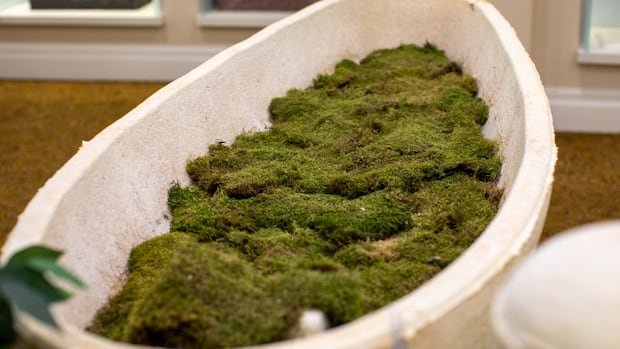Welcome to our weekly newsletter focusing on environmental trends and sustainable solutions. I’m Anand, and our science and climate team delves into an intriguing green burial practice this time, shedding light on what we leave behind on Earth.
This week’s highlights include the availability of coffins made from fungi, the challenge of corporate climate targets stalling, and the consequences of compostable products turning into litter.
Imagine being buried in a coffin crafted from fungi, an eco-friendly option priced at $3,750. This unique coffin, called Loop Living Cocoon, is made from upcycled hemp fibres and mycelium, a material used in various sustainable products. The appeal lies in its biodegradability, aligning with customers’ environmentally conscious values even in death.
The inventor, Bob Hendrikx of Loop Biotech, emphasizes the coffin’s swift decomposition compared to traditional coffins, contributing positively to soil biodiversity. This innovative approach has gained traction in Europe and is now making its way to North America.
Conventional burial practices, like cremation and traditional burials, have varying environmental impacts, with cremation emitting around 200 kilograms of CO2-equivalent per person. In contrast, natural burials are gaining popularity, reflecting an increasing demand for eco-friendly alternatives in recent years.
However, as compostable products become more prevalent, their true environmental impact comes into question. Marketplace’s experiment revealed that only a few compostable items completely broke down after 14 weeks, raising concerns about their disposal in landfills. The complexity of composting regulations across Canadian municipalities further complicates the proper disposal of these products.
Experts advocate for standardization and greater transparency in compostable product labeling to guide consumers towards more sustainable choices. The focus is shifting towards reusables to reduce environmental harm caused by single-use items.
By promoting reusables and advocating for industry responsibility, we can collectively move towards a more sustainable future. Stay tuned for more environmental insights every Thursday in your inbox.
Thank you for reading, and feel free to share your questions, feedback, or story suggestions with us at whatonearth@cbc.ca.
Editors: Emily Chung and Hannah Hoag | Logo design: Sködt McNalty

